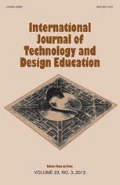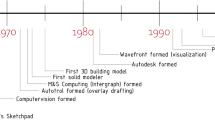Abstract
In recent years, technological advances had an impact on the field of education, and computer technologies were started to be used mainly in visual arts, architecture and planning departments in colleges. However, applications such as the use of conventional drawing tools and graphical techniques, sketching, drawing plans, sections, and elevations on paper and production of models are still prevalent in landscape architecture, architecture, interior design or planning departments. Digital technologies are also utilized as supplementary tools. The current article scrutinized student attitudes towards digital and conventional drawing methods in landscape architecture department environmental design studios and the impact of these techniques on the academic success in the course. The study was conducted with KTU Landscape Architecture Department students. Initially, an analysis of variance was conducted to determine whether there was a difference between student attitudes towards conventional and digital drawing techniques in environmental design studio. It was determined that there was a difference between the attitudes of the students between the items 3, 4, 5, 7, 8, 10, 12, 14, 15, 18, 20, 21, 22, 23 in the scale that contained statements (23 items) to measure student attitudes (p < .05), and no difference was observed between the student attitudes in remaining items (p > .05). The highest difference was found (F = 168.200) in item 23, followed by items 18 (F = 106,290), 10 (F = 104,533), and 14 (F = 103.292). In the second stage, to determine the effects of using digital or conventional drawing techniques in landscape design studio on the student achievement in the course, a quasi-experimental study was conducted with a pre-test post-test model with control group. It was determined that the pretest findings had a significant effect on both groups (p < .05). Digital and conventional drawing techniques that students learned in environmental design studio were correlated with their academic achievements and the difference between the groups was significant.

Similar content being viewed by others
References
Akbulut, D. (2010). The effects of different student backgrounds in basic design education. Procedia-Social and Behavioral Sciences, 2(2), 5331–5338.
Akipek, F. (2004). Bilgisayar teknolojilerinin mimarlıkta tasarım geliştirme amaçlı kullanımları (Doctoral dissertation).
Al-Kodmany, K. (1999). Using visualization techniques for enhancing public participation in planning and design: process, implementation and evaluation. Landscape And Urban Planning, 45(1), 37–45.
Atılgan, D. (2006). Gelişen tasarım araç ve teknolojilerinin mimari tasarım ürünleri üzerindeki etkileri (Doctoral dissertation, DEÜ Fen Bilimleri Enstitüsü).
Aybar, A.M. (2015). Sayısal bilgi işlemenin mimarlık ve tasarım nesnesi üzerindeki etkileri (Doctoral dissertation).
Bademci, V. (2006). Tartışmayı sonlandırmak: cronbach'ın alfa katsayısı, iki değerli [0, 1] ölçümlenmiş maddeler ile kullanılabilir. Atatürk Üniversitesi Kazım Karabekir Eğitim Fakültesi Dergisi, 13, 438–446.
Biggio, M., Vázquez, S. M., & García, S. M. (2015). From representation to construction: A study of graphic skills in students newly admitted to architecture and design courses. Universidad de Buenos Aires, Argentina, technical paper. Australasian Journal of Engineering Education, 20(1), 95–102.
Bilda, Z., & Gero, J. S. (2004). Analysis of a blindfolded architect’s design session. Visual and Spatial Reasoning in Design, 3, 121–136.
Bilgiç, D. E., & Konak, N. (2016). Tasarı geometri-teknik resim ve perspektif derslerinin, mimarlik eğitimi düşünsel altyapisina etkisi. Mimarlık ve Yaşam, 1(1), 1–11.
Burmabıyık, A. (2015). Geometrik cisimlerin öğretimi için geliştirilen 3 boyutlu mobil uygulamalar hakkında öğrenci ve öğretmen görüşleri (Master’s Thesis). Balikesir University, Institute of Science and Technology, Department of Computer and Teaching Technology Education.
Büyüköztürk, Ş.(2001). Deneysel desenler: öntest-sontest kontrol grubu desen ve veri analizi (2. baskı). Ankara: Pegem A Yayıncılık. İlköğretim Online, 12(2), 1–3.
Can, A. (2016). SPSS ile bilimsel araştırma sürecinde veri analizi. Ankara: Pegem Akademi.
Çivici, T., & Kale, S. (2007). Mimari tasarim bürolarinda bilişim teknolojilerinin kullanimini etkileyen faktörler: bir yapisal denklem modeli [factors that influence acceptance of information technologies in architectural design firms: a structural equation model]. İnşaat Yönetimi Congress Proceedings (pp. 119–128). İstanbul: İMO İstanbul Subesi Maya publishing.
Çolakoğlu, B., & Yazar, T. (2007). Mimarlik eğitiminde algoritma: stüdyo uygulamalari. Gazi Üniversitesi Mühendislik-Mimarlık Fakültesi Dergisi, 22(3), 379–385.
Demirbaş, O. O., & Demirkan, H. (2003). Focus onarchitectural design process through learning styles. Design Studies., 24(2003), 437–456.
Demirbaş, O. O., & Demirkan, H. (2007). Learning styles of design students and the relationships of academic performance and gender in design education. Learning and Instruction., 17(2007), 345–359.
Doheim, R. M., & Yusof, N. (2020). Creativity in architecture design studio assessing students’ and instructors’ perception. Journal of Cleaner Production, 249, 119418.
Donath, D., & Regenbrecht, H. (1996). Using virtual reality aided design techniques for three-dimensional architectural sketching. In P. McIntosh, & F. Ozel (Eds.), Design Computation, Collaboration, Reasoning, Pedagogy. ACADIA Conference Proceedings (pp. 201–212). Tucson, Arizona: University of Arizona publishing.
Duzenli, T., Alpak, E. M., & Eren, E. T. (2017a). Artistic plant representation techniques in landscape architecture. Fine Arts, 12(3), 177–184.
Duzenli, T., Yilmaz, S., & Alpak, E. M. (2017b). The effects of model making on design and learning in landscape architecture education. Eurasian Journal of Educational Research, 17(70), 121–134.
Düzenli, T., & Alpak, E. M. (2016). Peyzaj mimarliği eğitiminde doğaya öykünme yaklaşiminin yaraticilik üzerindeki etkisi. Mimarlık ve Yaşam Dergisi, 1(1), 13–21.
Düzenli, T., Alpak, E. M., Çiğdem, A., & Eren, E. T. (2018). The effect of studios on learning in design education. Journal of History Culture and Art Research, 7(2), 191–204.
Eceoğlu, A. (2012). Teknolojik gelişmelerin mimarlik mesleğine yansimalari ve simülasyon programlari’nin mekan tasarimina etkisi. The Turkish Online Journal of Design, Art and Communication, 2(2), 78–93.
Ertan, E. (2016). İç mimarlık ve çevre tasarımı sunumlarında simülasyon tabanlı görsel efektlerin sağladığı olanaklar, kısıtlamalar ve çözüm öneriler (Master’s thesis). Başkent Üniversitesi Sosyal Bilimler Enstitüsü.
Ertekin, M., & Çorbacı, Ö. L. (2010). Üniversite kampüslerinde peyzaj tasarımı (Karabük Üniversitesi peyzaj projesi örneği). Kastamonu Üniversitesi Orman Fakültesi Dergisi, 10(1), 55–67.
Felleisen, M. (2001). How to design programs: an introduction to programming and computing. Cambridge, Massachusetts, London, England: MIT Press.
Ferguson, G. A., & Takane, Y. (1989). Multiple-comparison procedures. Statistical analysis in psychology and education, 321–329.
George, B. H., Summerlin, P., & Fulford, T. (2019). Teaching and learning software in landscape architecture: a survey of software use amongst faculty and students. Journal of Digital Landscape Architecture, 354–362.
Goldschmidt, G., & Smolkov, M. (2006). Variances in the impact of visual stimuli on design problem solving performance. Design Studies, 27, 549–569.
Goldschmidt, G. (2003). The backtalk of self-generated sketches. Design issues, 19(1), 72–88.
Hong, S. W., El Antably, A., & Kalay, Y. E. (2019). Architectural design creativity in multi-user virtual environment: a comparative analysis between remote collaboration media. Environment and Planning B: Urban Analytics and City Science, 46(5), 826–844.
Hughes, J. F., & Foley, J. D. (2014). Computer graphics: principles and practice. United States of America, Willard, Ohio: Pearson Education Inc.
Jones, J. C. (1992). Design methods. New York: Van Nostrand Reinhold.
Kahraman, T. (2006). İstanbul kentinde kentsel dönüșüm projeleri ve planlama süreçleri. Planlama, 2, 93–101.
Kahvecioğlu, N. P. (2001). Mimari tasarım eğitiminde bilgi ve yaratıcılık etkileşimi (Doctoral dissertation).
Kalay, Y. E. (2004). Architecture’s new media: principles, theories, and methods of computeraided design. Cambridge, Massachusetts, London, England: MIT Press.
Karadağ, D. (2011). Dijital tasarım ve üretim araçları ile mimaride malzeme kullanımının dönüşümü (Master’s thesis). Yıldız Teknik Üniversitesi Sosyal Bilimler Enstitüsü.
Kirk, R. E. (1968). Experimental design: proceduresfor the behavioral sciences. Belmont, CA: Brooks/Cole.
Korkut, A., & Özyavuz, M. (2016). Planlama ve tasarim eğitiminde teknoloji altyapisinin gerekliliği üzerine bir araştirma. JOTAF/Tekirdağ Ziraat Fakültesi Dergisi, 13(2), 21–33.
Kwan, T. &Yunyan, J. (2005).Students’ learning styles and their correlation with performance in architectural design studio.Design Studies. 24(2005), 19–34.
Linn, M. C. (2000). Designing the knowledge integration environment. International Journal of Science Education, 22(8), 781–796.
Mahmoud, N. E., Kamel, S. M., & Hamza, T. S. (2020). The relationship between tolerance of ambiguity and creativity in architectural design studio. Creativity Studies, 13(1), 179–198.
Maier, P. H. (1994). Raeumliches vorstellungsvermoegen. Frankfurt a.M., Berlin, Bern, New York, Paris, Wien: Lang.
O’Neill, D. K., & Gomez, L. M. (1994). The collaboratory notebook: a networked knowledge-building environment for project learning. In Educational Multimedia and Hypermedia, June 1994, Proceedings of ED-MEDIA 94, World Conference on Educational Multimedia and Hypermedia. Vancouver, British Columbia, Canada.
Orhon, A. V. (2012). Akıllı malzemelerin mimarlikta kullanimi. ege mimarlık, 82, 18–21.
Öztürk, U.A. (2016). Tasarım stüdyosuna teknolojinin entegrasyonu: sanal tasarım stüdyosu.
Paar, P. (2006). Landscape visualizations: applications and requirements of 3D visualization software for environmental planning. Computers, environment and urban systems, 30(6), 815–839.
Pallant, J., & Manual, S. S. (2007). A step by step guide to data analysis using SPSS for windows. SPSS Survival Manual: Open University Press, New York.
Raxworthy, J. (2017). The discourse of the digital in contemporary landscape architecture. Journal of Landscape Architecture, 12(2), 88–93.
Rodiek, J. E., & Steiner, F. R. (1998). Special issue: landscape architecture research and education. Landscape and Urban Planning, 42(2–4), 73–74.
Rosli, M. F., Razak, A. S., Ahmad, N. A., Keumala, N., & Al Sabahi, M. H. (2019). Digital Design Approach in Architectural Studio Project. Case Study: University of Malaya (UM). International Journal of Business and Social Development (IJBSD), 1(1), 1–14.
Saghaf, M. R., Franz, J., & Crowther, P. (2012). Perceptions of physical versus virtual design studio education. International Journal of Architectural Research, 6(1), 6–22.
Schön, DA (1985). The design studio: An exploration of its traditions and potentials. International Specialized Book Service Incorporated.
NP Seçkin YÇ Seçkin ÖB Seçkin 2011 Sürdürülebilir Peyzaj Tasarımı ve Uygulama İlkeleri Literatür Yayıncılık 231
Shaw, M. (1994). Beyond objects: a software design paradigm based on process control (No. Cmu-Cs-94–154). Carnegıe-Mellon Unıv Pıttsburgh Pa School Of Computer Scıence.
Sorby, S. A. (2007). Developing 3D spatial skills for engineering students. Australasian Journal of Engineering Education, 13(1), 1–11.
Svoboda, J. (1992). The secret of theatrical space. TD&T 5(28), 14,19.
Tagliabue, B. (2011). Conversando con. benedetta tagliabue. EGA. Revista de Expresión Gráfica Arquitectónica, 16(17), 15–27.
Tarakci Eren, E., & Var, M. (2017). Education process and development of environmental design project. International Journal of Educational Sciences, 19(2–3), 144–151.
Tarakci Eren, E., Düzenli, T., & Yılmaz, S. (2018a). Usporedba uporabe tradicionalnih i digitalnih tehnika vizualizacije u obrazovanju za dizajn za okoliš. Croatian Journal of Education: Hrvatski časopis za odgoj i obrazovanje, 20(4), 1149–1171.
Tarakci Eren, E., Yılmaz, S., & Düzenli, T. (2018b). Drawing a planting plan in the process of the environmental design project (p. 67). Engıneerıng Plannıng And Desıgn: Academıc Researches In Archıtecture.
Tarakci Eren, E., Düzenli, T., & Akyol, D. (2018c). Attitudes of landscape architecture students towards biomorphic and parametric design approaches in environmental design. Anadolu Üniversitesi Sanat ve Tasarım Dergisi, 8(1), 126–143.
Uğur, A., & Özgür, E. (2003). İnternet üzerinde üç boyut ve mimarlıkta web3d. IX. Türkiye’de İnternet Konferansı, Bildiri, 3, 1–8.
Uluoğlu, B. (1990). Mimari tasarım eğitimi: tasarım bilgisi bağlamında stüdyo eleştirileri (Doctoral dissertation).
Yakın, B. (2012). Tasarım sürecinde görsel düşünme ve görsel anlatım ılişkisine analitik bir yaklaşım. Hacettepe Üniversitesi Güzel Sanatlar Enstitüsü, İç Mimari ve Çevre Tasarımı Anasanat Dalı/ İç Mimarlık Sanat Dalı. Ankara.
Yıldırım, T., Özen A., & İnan N., (2008). Uzaktan mimari tasarım eğitiminde internet teknolojilerinin kullanımı. Bilişim Teknolojileri Dergisi, 1(2).
Yılmaz, S. (2015). Landscape design of a campus outdoor spaces: süleyman demirel university faculty of forestry building. Kastamonu University Journal of Forestry Faculty, 15(2), 297–307.
Yılmaz, S., Mumcu, S., & Düzenli, T. (2017). Examining the academic success of the students in drawing techniques course: the case of freshmen in landscape architecture. European Online Journal of Natural and Social Sciences, 6(3), 406–416.
Yılmaz, S., Mumcu, S., Düzenli, T., & Özbilen, A. (2016). Analyzing the unity concept in design on student works: A case study of architectural design course. Inonu University Journal of Art and Design, 6, 1–12.
Author information
Authors and Affiliations
Corresponding author
Additional information
Publisher's Note
Springer Nature remains neutral with regard to jurisdictional claims in published maps and institutional affiliations.
Rights and permissions
About this article
Cite this article
Eren, E.T., Yılmaz, S. The student attitudes towards digital and conventional drawing methods in environmental design studios and the impact of these techniques on academic achievement in the course. Int J Technol Des Educ 32, 617–644 (2022). https://doi.org/10.1007/s10798-020-09605-x
Accepted:
Published:
Issue Date:
DOI: https://doi.org/10.1007/s10798-020-09605-x




